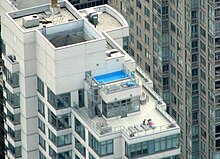★ Israel's Newest $50M Penthouse, Plunge Pool Included ★
★ Israel's Newest $50M Penthouse, Plunge Pool Included ★
History
The idea of a penthouse apartment was born in the 1920s, called “The Roaring Twenties”, when economic growth brought a construction boom to New York City, the heart of the American economy. The high demand for living in urban areas and the wealth of Americans led to luxury apartments on the top floor or floors of a building.One of the earliest penthouse apartments in the city was publisher Conde Nast’s duplex penthouse at 1040 Park Avenue. The original 1923 plan for the building provided three units on each floor with additional maids’ rooms on the roof, but in 1924 the building’s upper spaces were constructed to provide a grand duplex for Nast. Connected by a staircase to the rooftop entertaining salons, the corner unit at the top floor was redesigned to be private family quarters. The whole unit was decorated in the French manner by Elsie de Wolfe. Completed in 1925, Conde Nast’s duplex penthouse was used for many lavish parties, which were made famous as much by guest lists as by the entertainment.[1]
Architectural definition
In architecture, the term penthouse is used to refer to a structure on the roof of a building that is set back from the outer walls. These structures do not occupy the entire roof deck. High-rise buildings will often have penthouse structures enclosing mechanics such as those in an elevator machine room.While European designers and architects long recognised the potential in creating living spaces that make use of rooftops and such setbacks, in US cities, exploitation of these spaces began in earnest in the 1920s. It was a matter of news when the development of a rooftop apartment at the Plaza Hotel overlooking Central Park was announced in 1923, and this was followed by rapid development of luxury penthouse apartments in the following years.[2]
When used as private outdoor terrace spaces, setbacks can allow for significantly larger and more protected spaces than cantilevered balconies. Due to the desirability of this outdoor space, buildings may be designed with such setbacks on more than one of its uppermost levels, to allow apartments on several levels to feature such terraces. Not all penthouses have such terraces, but they are a desired feature. One such space may be divided among several apartments, or one apartment may occupy an entire floor. A penthouse apartment/condominium may also provide occupants with private access to the roof space above the apartment, instead of, or in addition to, terrace space created by an adjacent setback.
Location and size
Penthouse apartments have not only the advantages of a regular apartment such as security and convenient location but also all those of a house such as size and design.Similar to apartments, penthouses are usually located in the heart of busy cities yet offer a sense of being situated far away from or above noisy and crowded urban life. Such locations provide easy access to hotels, restaurants, malls, and schools. Overcoming the issue of small space in regular apartments, penthouses are usually large.
Design

Trump Plaza Penthouse View Jersey City
Features not found in the majority of apartments in the building may include a private entrance or elevator, or higher/vaulted ceilings. In buildings consisting primarily of single level apartments, penthouse apartments may be distinguished by having two or more levels. They may also have such features as a terrace, fireplace, more floor area, over-sized windows, multiple owner suites, den/office space, jacuzzi, and more. They might be equipped with luxury kitchens featuring stainless steel appliances, granite counter-tops, breakfast bar/island, and more.
Penthouse residents often have fine views of the city skyline. Access to a penthouse apartment is usually provided by a separate elevator. Residents can also access a number of building services, such as pickup and delivery of everything from dry cleaning to dinner; reservations to restaurants and events made by building staffers; and other concierge services.
For example: the top floor penthouse of Robert A. M. Stern’s 15 Central Park West 20-storey apartment building in New York has the following amenities:[3]
- Set on a rooftop terrace, the penthouse has a view of the midtown skyline and at its feet is the whole geometry of Central Park.
- Penthouse ceiling was constructed to be thirteen and a half feet high. Windows were made to be as high and wide as they could be.
- Each section of the penthouse was furnished with unique materials. For the entrance gallery: marble floors and parchment panels framed in mahogany. For the library: Brazilian rosewood. For the dining room: Venetian stucco. For the master bedroom: reeded plasted. For the kitchen: Jaguar-green lacquer, bamboo, and textured glass. For the interiors of the fireplaces: long, narrow 19th-century bricks imported from France.
- This penthouse has a very sophisticated technology system. An anemometer was installed on the roof to measure wind speed so the terraces’ canvas awning can be retracted and does not get ripped off the penthouse’s exalted façade. Moisture sensors were used detect a leak, automatically sending an e-mail to the building managers. Temperature sensors, strapped to pipes, send an e-mail when the temperature deviates by as little as a single degree from the temperature set by the client.
Cultural references
Penthouse apartments are considered to be at the top of their markets, and are generally the most expensive, with expansive views, large living spaces, and top-of-the line amenities.[4] Accordingly, they are often associated with a luxury lifestyle. Publisher Bob Guccione named his magazine Penthouse, with the trademark phrase "Life on top".[5]★ Israel's Newest $50M Penthouse, Plunge Pool Included ★
| This article needs additional citations for verification. (December 2012) |




No comments:
Post a Comment